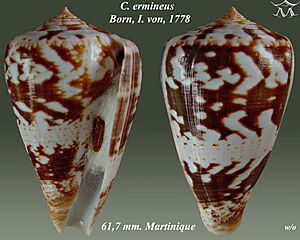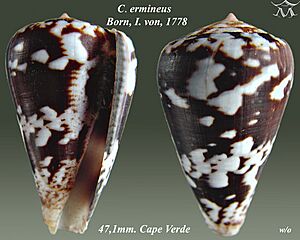Conus ermineus facts for kids
Quick facts for kids Conus ermineus |
|
|---|---|
 |
|
| Apertural and abapertural views of shell of Conus ermineus Born, I. von, 1778 | |
| Conservation status | |
| Scientific classification | |
| Synonyms | |
|
The turtle cone, also known as Conus ermineus, is a type of sea snail. It's a marine gastropod, which means it's a kind of mollusk that moves on its belly, like a snail. This snail belongs to the Conidae family, often called cone snails.
Just like all other cone snails, Conus ermineus is a predatory animal. This means it hunts other creatures for food. These snails are also venomous. They can "sting" humans, so it's very important not to touch them if you ever see one alive.
Contents
Where Do Turtle Cones Live?
This amazing snail lives in several different parts of the world. You can find it in the warm waters of the Caribbean Sea. It also lives in the Gulf of Mexico and off the coast of South America.
In the Atlantic Ocean, Conus ermineus is found near West Africa and the Cape Verdes islands. You can also spot it in the Indian Ocean, especially off the coast of Tanzania.
What Does a Turtle Cone Look Like?
The shell of a Conus ermineus can grow quite large. The biggest shell ever recorded was about 103 millimeters long. That's about the length of a typical smartphone!
These snails are expert hunters. They mainly eat fish. To catch their prey, they use a special tooth that looks like a tiny hollow harpoon. They shoot this harpoon into small fish and inject them with venom. This venom quickly paralyzes the fish, making it easy for the snail to swallow its meal.
Where Do Turtle Cones Live in the Ocean?
Conus ermineus snails live in the ocean at different depths. They can be found in very shallow waters, right at the surface (0 meters deep). They can also live much deeper, down to about 101 meters below the surface.
Why Are Turtle Cones Dangerous?
Conus ermineus is a venomous species. This means it produces a powerful venom. Because of this, it can sting humans. If a person is stung, it can be very serious. That's why it's always best to be very careful around these snails. You should never try to pick up or handle a live one.
Images for kids






